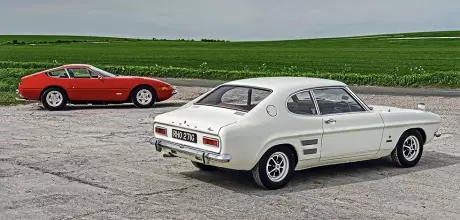1973 Ferrari 365 GTB/4 Daytona vs. 1969 Ford Capri 1600GT
Worlds Apart We stage an extraterrestrial encounter between Ford Capri and Ferrari Daytona to discover their shared Sixties GT soul. In 1969, Ferrari’s 365GTB/4 Daytona epitomised the Sixties GT dream, while the Ford Capri brought it to the masses. What might their drivers have made of each other on the rare occasion their worlds collided?
Words SAM DAWSON
Photography JORDAN BUTTERS
Ford Capri and Ferrari Daytona -Worlds Apart — Everyman grand tourer confronts the exotic we all dreamed of
INSIDE THE REALITIES OF CAR BUYING IN THE ’70S
How would Capri man have felt encountering spaceship Daytona in 1969? It’s time to probe
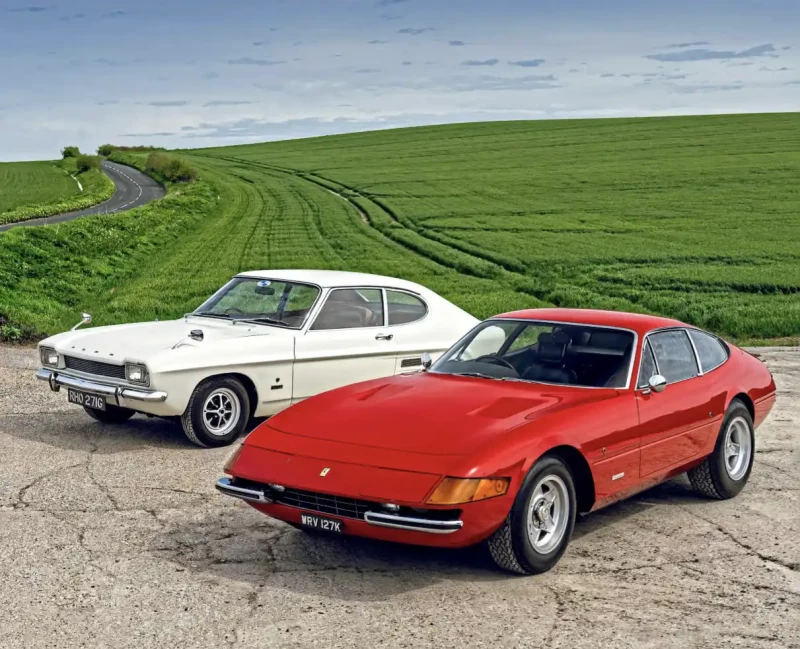
A smile of deep satisfaction breaks across Capriman’s face. He has everything he ever wanted. His Welsh-made Smiths Empire watch, looking like Sir Edmund Hillary’s Imperial Automatic at first glance but only costing £12, pokes out from the cuff of his tailored Burton shirt as he rests an arm on the top of the driver’s door of his new car. The window is wound down so he can better admire the reflection of his machine in the suburban shop parade fronts as he edges through a Chelmsford traffic jam.
‘Imitators were all chasing a gran turismo dream that, for the briefest of moments, both the Capri and Daytona inhabited at the same time’
He cannot help but feel a tad narcissistic. Ahead and behind, the rest of the traffic consists of porridgy old Fifties lumps, or more modern but brutally austere box-cars. Other, older people in his Foster Grant-tinted field of vision wear Trilbys and headscarves. Shopkeepers in brown store-coats shuffle stock around on the pavement. But compared to the staid ordinariness around him, he genuinely looks like the leading man from a slick big-screen adventure caper. He may inhabit a world of sweaty vinyl, fake wood, staticky nylon and thinly-plated nickel, but it all looks and feels like the trappings of a much more aspirational, exclusive world.

And that includes his car. It may have come from the same dealership that sold him an Anglia a few years earlier, and at £1121 cost no more than a mid-range Cortina, but what shimmers back at him from the General Electric Launderette window is a long-bonneted grand tourer. The badge on the side even says ‘1600GT’. The C-shaped rear window and overall proportions give it the first-glance look of a Jaguar E-type coup. – or Ferrari Daytona. As he peers down the flat bonnet he also gets a squared-off hint of Aston Martin’s brand new DBS, the car he recently saw George Lazenby squeal around the French Riviera in On Her Majesty’s Secret Service.
‘The only other cars costing this kind of money wore the Spirit of Ecstasy’
Then there’s the name. True, Ford had used it in wordsalads on forgettable wallowers like the Consul Capri Classic before, but standing alone gave it a new sense of cool. It was named after an Italian island where the wealthy glitterati went on holiday. It wasn’t just a name – it felt like a suggestion as to where you should want to drive it.
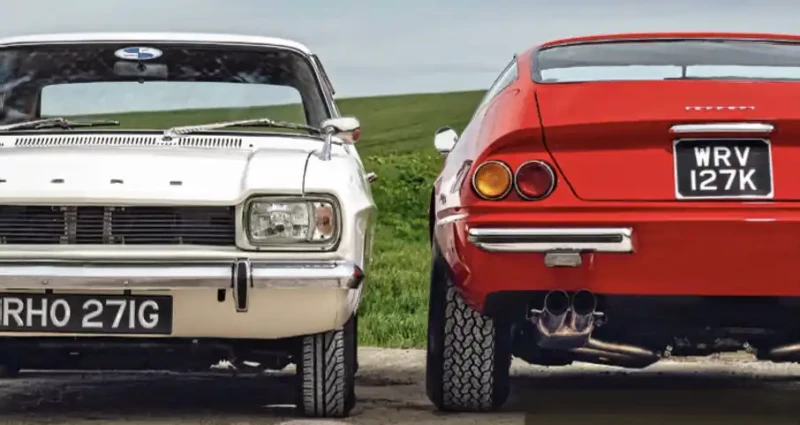
United by a mission to deliver grandtouring pleasure; divided by mere cost
Even in heavy English traffic, the Capri is a comfortable place to spend time. The driving position is long-legged and semireclined. Most Capri owners would never get the opportunity to drive a Jaguar E-type, so they’d be unaware of how similar the slick Ford four-speed gearbox feels to the 4.2-litre E’s as it slots around the gate. The gauges are cowled from the sun like a racer’s, and the thin-rimmed steering wheel feels light and positive. It’s unassisted, but once up beyond 40mph you can guide it with the fingertips of one hand as though you’re helming something bigger and servo-powered. It changes direction keenly, with only slight roll-angles.
‘Capri-man keeps his car in the outside lane with his right foot down, contemplating the day when he may well blast across Europe himself’
The rorty Weber-carburetted 1.6-litre Kent engine claims kinship with single-seaters and BSCC racers – something reinforced by Castrol adverts in colour Sunday supplements when the Capri was new – and while it’s sweet-spinning and smooth, it starts to run out of puff and sounds coarse above 4000rpm. It’s best treated as a torquey cruiser anyway, and it encourages you to hurry it into fourth by 60mph.

‘The ’67 Daytona victory the car was nicknamed after was a single green shoot in an otherwise fallow period for the Scuderia’
On the dual-carriageway, the Capri would have seemed vastly superior to most other cars in 1969. Older cars with no overdrive ratios and all-round drum brakes sat at a cautious 50mph at best, even some of the sports cars, to the point where 0-50 was regarded as a benchmark acceleration figure by car magazines. Other saloons only punched their way briefly up to 70mph to get round slowcoaches, wind whistling around their rain gutters and upright windscreens, and under-geared axle whine putting them off trying to sustain a cruise at that kind of speed. But not the Capri. That hunkered-down bodyshell with its 0.39Cd drag coefficient might make it heavier than the Cortina, but it’s quiet as a result of its slipperiness.
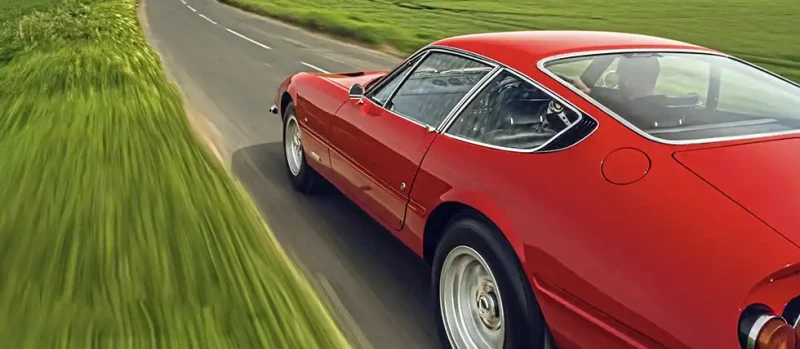
Unlike other cars on the road, Capri-man keeps his car in the outside lane with his right foot down, contemplating the day when he may well drive the family down to Dover in the Capri, take the Townsend Thoresen ferry to Calais, and blast across Europe himself. Gunning for the ton for the first time since he rode a Triumph Tiger as a teenager, he winds up his window, stubs out his Player’s No.6, turns up Edison Lighthouse on the radio, and buries his right foot in the nylon.
Beyond 75mph, it’s still noticeably accelerating. But he’s acutely aware that, despite having discs up front, the brakes seem to be the car’s weak link, wooden-feeling underfoot and requiring of a firm shove to get it to stop. He keeps a keen eye on his wobbling mirrors in case he needs to slow urgently. With the Kent engine giving off a rough snarl above 5000rpm, he briefly sees 90mph before the sight of something closing in the rear-view mirror gives him pause for thought. Anticipating a police Rover P6, he backs off the accelerator until the mirror stops vibrating and he can get a better look at his pursuer.
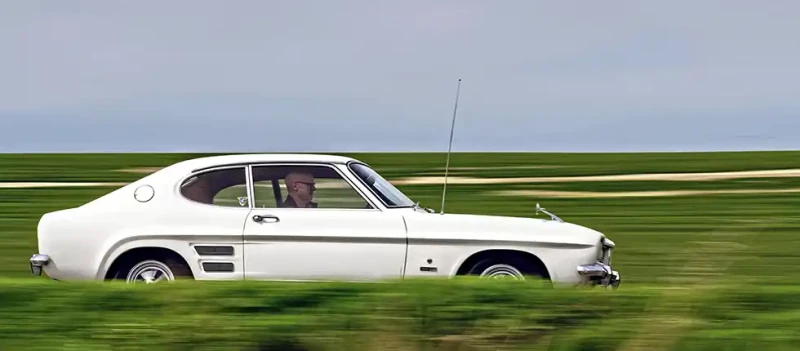
It's not a Rover. It’s not even the police. It’s low, wide and red, its curvaceousness tempered by the curt scowl of its eggcrate grille and mean quarter-bumpers. And the fiery downdraught quad-cam V12 howl it’s making comes straight from the Back Stretch at Daytona.
From behind the drilled-spoke wheel of the Ferrari 365 GTB/4, the Capri looks under-tyred and dainty, especially with its tiny Escort-sourced rear light clusters. Sunlight glints off the Breitling on the Ferrari driver’s wrist, but he’s not stopping to admire any reflections. With 352bhp comes great responsibility, and the high, domed scuttle-line has a habit of obscuring the Daytona’s enormous bonnet from the perspective of the low-slung and snug leather driver’s seat. Dabbing the brake pedal with the toe of a tan Barker brogue while hitting the close-set floorhinged accelerator with its heel, he shifts down from fifth gear to fourth and engine-brakes. In that moment, the Daytona is quite possibly the only car on that stretch of road to boast a five-speed gearbox, let alone a race-bred rear-mounted transaxle unit.
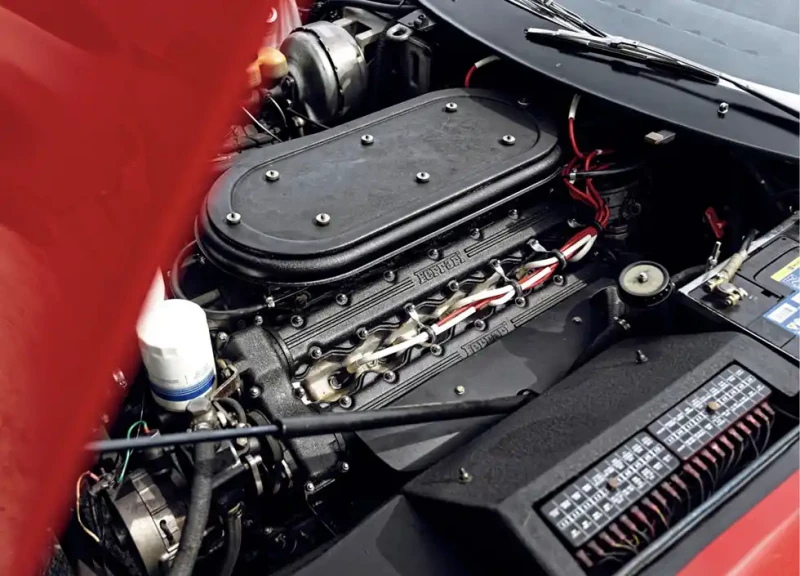
Capri-man meekly signals back into the inside lane with the shuffling Vivas and Imps, jaw dropped as the Daytona sears past, exhausts crackling. He desperately wishes he inhabited its world. He has no idea that, with his knees splayed round the awkwardly-angled steering wheel, deep down, there are times when the Ferrari driver wished he owned something a bit less specialised. That gearbox is unco-operative in the mornings, sometimes forcing him to set off in second gear, and he’s thankful for the Veglia Borletti air conditioning unit, because the combination of black leather, Alcantara and heavy controls makes driving it hard work. Not to mention that with difficult-to-judge extremities and limited visibility through the shallowangled rear screen, the Ferrari is a nightmare to drive in traffic, and that’s even before the heavy clutch is taken into account. And yet, these are the hardships you have to put up with in order to own the fastest road car in the world.
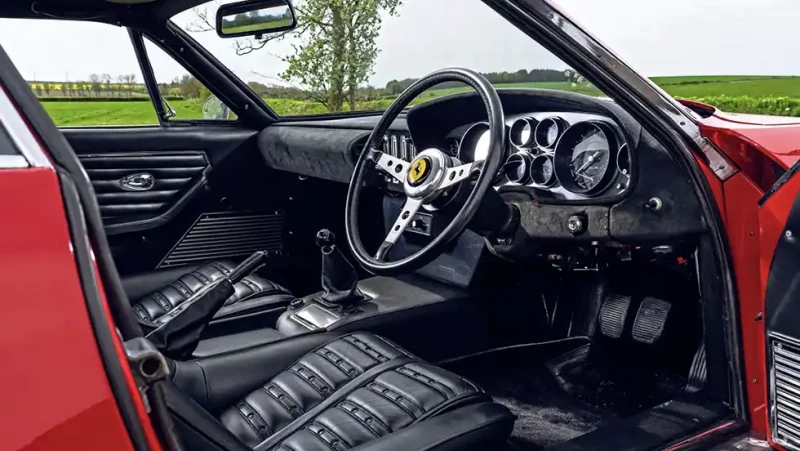
When Ford called the Capri ‘the car you always promised yourself’, it was referring to an idiom rather than a specific. In a world before mid-engined supercars, big handbuilt frontengined grand tourers created by Italian design houses vied with super-luxury saloons from the likes of Rolls-Royce and Mercedes-Benz as the world’s most desirable cars. It’s a bit lazy to characterise the Capri merely as a European Mustang. Yes, like the Mustang the Capri was a coup. based on a basic Ford saloon. However, Mustang designer Philip T Clark, who also styled the GT40, turned to Europe for Capri inspiration before his untimely death at 32. It’s worth remembering that the Capri was sold in the US through Mercury dealerships, marketed as a ‘sexy European import’. This was no simple muscle car – its inspirations were the likes of Alfa Romeo and BMW. Middle rungs on a ladder topped by the Daytona.
And yet, even if Capri-man was a magazine-reading car enthusiast, the Daytona would have been something mysterious and enigmatic, not a highly recognisable product of a hard-sold global brand. He might have seen a single grainy photo of one from the October 1968 Paris Auto Salon, but after that, as with many Ferraris, it would have disappeared from public view.
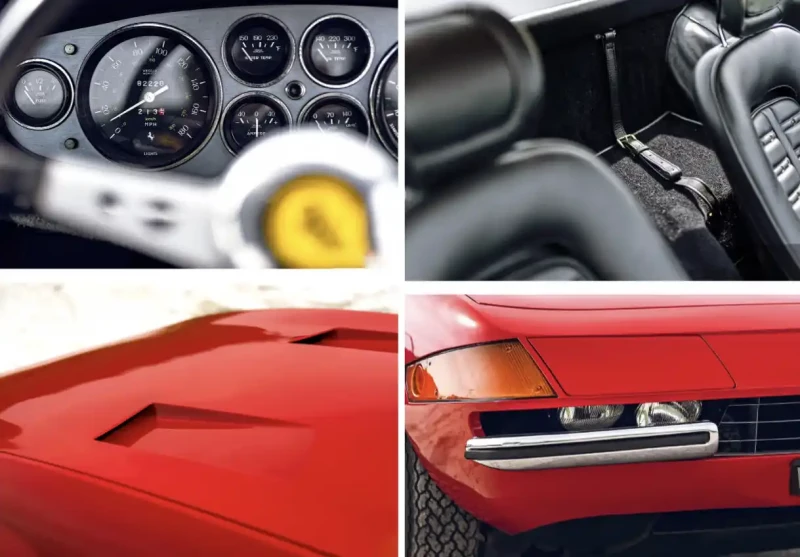
It was the very last Ferrari to have been created and marketed under Enzo’s regime before the Fiat buyout, and he never allowed his cars out for testing. Even when trusted Maranello confidant Paul Fr.re finally got his hands on one for Motor in August 1969, it was actually a battered preproduction hack sourced via Sergio Scaglietti rather than Ferrari itself. As with other pre-Fiat Ferraris, other British journalists had to wait until Colonel Ronnie Hoare’s Surrey-based Maranello Concessionaires had the first right-hand-drive examples, in February 1970, before they could get a drive in one. By the time Autocar carried out its first road test, in September 1971, the Daytona was two years old.
And the price was outrageous. Even Roger Bell of Motor called its £8750 – the equivalent of £170k today – ‘a stupid price for a car’. Granted, a new 812GTS, the Daytona’s modern descendent, is £293,150, but in 1969 the only other cars costing that kind of money wore the Spirit of Ecstasy. A certain level of capaciousness and effortless luxury was expected if you were parting with a figure that would have bought Capri-man’s threebed semi and the identical house next door too.
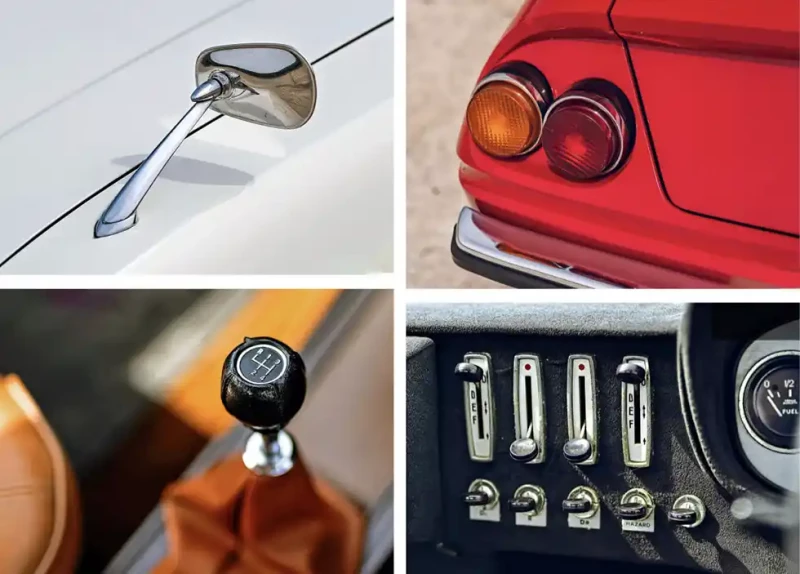
As the Daytona draws alongside, Capri-man peers past its elegant finger-pull doorhandles, trying to see if there’s a celebrity at the wheel. It took a certain calibre of big name to stump up the cash for one, in an era when even England’s World Cup-winning captain Bobby Moore – who opened the 1970 Earls Court Motor Show the year the right-hand-drive Daytona was unveiled – could only run to top-spec Jaguars. Daytona owners tended to be megastars. Cream’s Jack Bruce put his on the record sleeve of Things We Like, released in 1970. Bandmate Eric Clapton, James Hunt’s F1 team boss Lord Alexander Hesketh, and Roger Waters and Nick Mason of Pink Floyd were all early Daytona adopters. Had Capri-man seen this very car I’m driving today in 1974, it would have been Elton John behind the wheel, enjoying the proceeds of Goodbye Yellow Brick Road.
While the Daytona’s torpedo-like profile and massive wheels give it an element of thuggishness, that’s not to say it doesn’t possess a certain elegance. Its long bonnet actually makes it look bigger than it really is – by post-Testarossa standards it’s an elfin thing, narrow proportions promising a blend of deft-handling compact sports car and racetrack urge.
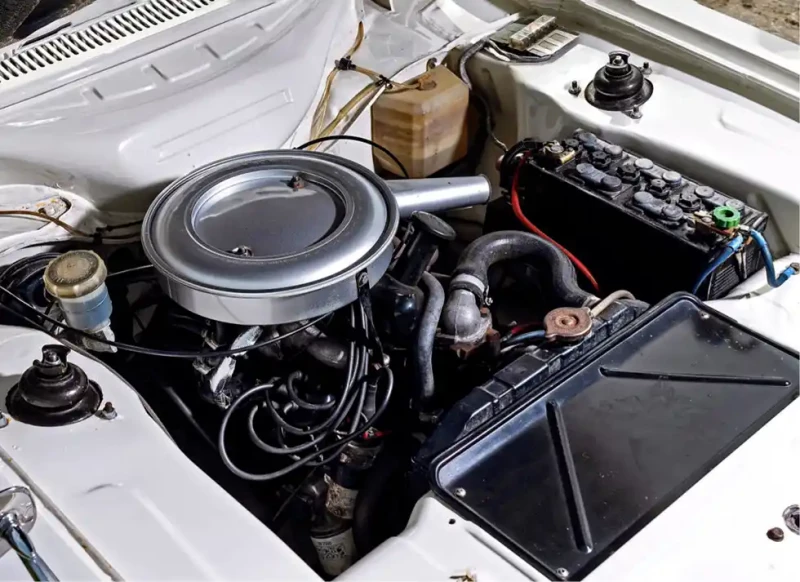
Despite appearances, the Daytona isn’t the most comfortable way to cross Europe, even in a hurry, and Daytona-man would have known it. At speed, the car seems to shrink around you, almost to the size of a Lotus Elan, given how neatly its chassis is balanced, how firmly the Michelin XWXs cling to the tarmac. However, even the Ferrari cannot defy physics for long once the lanes get tight. That high scuttle helps you to ignore the Daytona’s long-bonneted proportions up to a point, concentrating on its manageable width rather than its length, and it’s a compact car, especially compared to late-Sixties luxury saloons, but you have to keep bearing in mind the vast snout ahead of you. What’s more, the steering lacks the sportscar tactility of the Capri. Remarkably, it’s worm-and-peg on the Ferrari rather than the rack-and-pinion you’d expect of a sports car, even in 1969. It makes the Daytona something of a point-and- squirt blunt instrument at the sort of speeds where the Capri is at its most fun. And on B-roads, the Daytona’s power feels inaccessible, where you’re forever short-shifting and using the lower end of its rev range, sitting on lumps of torque to cannon between apexes rather than enjoying indulging the throttle – there is simply too much power to risk that.

Capri-man would tingle at that first memory of seeing the Daytona, wondering which of his car-minded friends to tell of his otherworldly encounter first. His mind might have turned to motor sport breeding, but it’s here where, unexpectedly, his Ford started to fight back in the pedigree stakes. Six years before the Capri was launched, Ford had attempted to buy Ferrari, originally with the intention of using the cars from Maranello to cast a halo effect over the rest of range.
Il Commendatore was intrigued, until he realised that the deal would involve having to cede control of Ferrari’s racing activities to Dearborn too. Snubbed, Ford embarked on its Total Performance programme, leading from the US with the Mustang on the road and the GT40 on track. However, by the time the Capri was launched, this ethos had spread across the Atlantic too, the Lotus Cortina acting as a warning shot.

In 1967, after Ford competition manager Henry Webb agreed to supply 1600GT engines to Brands Hatch-based Motor Racing Stables, Formula Ford was born as a new entry-level form of motor sport, putting the Capri’s Ford Kent on racetracks all over Europe. That same year, the Ford-badged Cosworth DFV V8 race engine was born, powering Graham Hill to the Formula One World Championship with the Lotus 49 in its maiden season. By 1969, the Ford-propelled Jackie Stewart had secured the DFV’s follow-up championship win in a Matra, and it powered 16 of the cars on the F1 grid. Off-track, Stewart was often photographed driving a blue Capri.
Ford wasn’t just influencing racing either. The Daytona had competition in the supercar stakes in the form of the De Tomaso Mangusta, a 155mph Ghia-styled mid-engined Italian supercar with a Ford small-block V8 under its gullwing-decked fastback. It piqued Dearborn’s interest sufficiently for Ford to get involved with De Tomaso, completing a buyout of Ghia a few months into Capri production. So by 1970, Ford had everything it had sought in its original pursuit of Ferrari. It dominated Formula One, endurance racing, rallying and touring cars. It owned an Italian design house and its name graced supercars.
Although it would be 1974 before Ghia got involved in the Capri’s design with the MkII, our Capri-man would still be imbued with a sense of smugness compared to the drivers of other mass-produced cars. Cooper’s star was starting to fall by the late Sixties, and BMC never cashed in on it with anything other than the Mini. Vauxhall had no response beyond the lukewarm Brabham Viva. And while there were sporty coupes in the Capri’s price bracket, like the MG BGT and Triumph GT6, they hid Fifties-rooted underpinnings beneath their sleek skins.
To make matters worse, you couldn’t accommodate a family in them, the implication being that sports cars were something you gave up once you had children, or indulged in once they’d left home. By contrast, you could treat a Capri like any number of three-box, two-door saloons. And yet everywhere you looked, you could see Ford partnerships with the likes of Lotus, Lola, Shelby and McLaren at the cutting edge of motor sport, the likes of which flat-capped and driving-gloved MG and Triumph owners could only dream. Even Ferrari struggled to counter the might of Ford in 1969 – it hadn’t won either Le Mans or the F1 Championship for five years. The 1967 Daytona 24 Hours victory the car was nicknamed after was a single green shoot in an otherwise fallow period for the Scuderia.
Ford’s ambitions for the Capri 1600GT were originally greater than the car which resulted. The international press launch took place in December 1968, with 250 journalists flown out to Cyprus and presented with cars badged 1600GT. These Capris boasted glassfibre bonnets concealing 1601cc, 120bhp Cosworth BDA engines, and road tests reported 100mph capability with ease. The Cosworth Capri was promised as a regular production car in Ford’s 1969 launch literature but never transpired, probably because the same engine proved much faster in the lighter Escort RS1600. To go as quickly as its little brother, the Capri needed the torquier, heavier 128bhp Essex V6, which formed the basis of the Capri’s competition variants while the idea of a BDA car was quietly dropped.
There were problems for early British customers too. Despite Ford’s Halewood factory being tooled up to build them from November 1968, strikes at the Girling factory resulted in cars sat in Ford’s yards with no brakes fitted. The domestic UK launch was a rushed affair amid torrential rain in January 1969, with just 1600 and GT variants available for journalists to fully evaluate on Boreham’s test track. The GT was filthy – it had been driven all the way from Halewood the night before and Ford didn’t have time to clean it before the road-testers got their hands on it.
It couldn’t have happened at a worse time for Ford, because demand for the Capri was huge. Before long into 1969, Ford’s 500 UK dealers had taken orders for twice as many Capris as they had expected to sell. This particular car I’m driving today is the earliest-known Capri on British roads. Its Essex-based buyer, a Mr T A Tarrant, would have been very lucky, his car genuinely standing out as unfamiliar and radical when he registered it on 20th February 1969, if only for a year before production ramped up to satiate demand.
According to owner Duncan Benham, Tarrant traded in an Austin 1300 for it, and ran the Capri for four years as a family car before his children outgrew the back seats. But as an order placed in January 1969, amid the strikes, the incomplete cars and the underwhelming British launch, it was pot luck as to whether Tarrant would have still been running around in the 1300 well into the final year of the Sixties.
It's almost as convoluted a process as the Daytona owner would have had to go through. For just one year before Elton John bought it, this car was owned by a Mr Dobbie of Edinburgh, who would have had to have pay a hefty deposit at Maranello Concessionaires, 400 miles away in Egham, Surrey, the sole Ferrari dealership for the whole of the UK, and join a waiting list that could have been anything from two to four years long and prone to fluctuating.
Ferrari’s attitude towards marketing was the polar opposite to that of Ford, to the point where it actually irritated those tasked with dealing in them. Maranello Concessionaires’ photographer Neill Bruce recalled that the only piece of marketing literature Ferrari had sent to Egham along with its demonstrator Daytona was a solitary, yellowing Polaroid, prompting MD Shaun Bealey to ask ‘How are we supposed to sell a £10,000 car from this?!’ Bruce ended up having to track down a willing early Daytona owner and persuade him to bring the car to Surrey to be properly photographed, the day before the London Motor Show, and the shoot had to take place inside the showroom to escape the miserable October weather outside, rather than Bealey’s favoured location of Engleford Green.
There’s every chance that when Elton John bought this Daytona, he was savvily jumping the queue, rather than having to slum it in a second-hand car. Like very early Capris, demand for Daytonas vastly outstripped supply. Anyone with one in the very early Seventies suddenly had a valuable asset, briefly worth more than it was when they bought it provided it was lightly used and properly serviced. If Elton called Bealey in 1974 to order a Daytona, there’s every chance he was offered the choice of waiting a few years for a new one, or spending similar money on one he could have immediately, that Bealey could vouch for. It’s not as though Elton would have been short of cash – he’d just had his third consecutive number one album her and in the US.
Queen bassist John Deacon went to place an order for a new Capri after their first hit, only for Freddie Mercury to criticise him, claiming the car ‘wasn’t rock star enough’, prompting him to cancel it. By the early Seventies though, the early gloss had started to come off the Capri. Its lingering association with the free-love attitudes of the Sixties – with gauchely saucy marketing mocked by Monty Python to boot – soon lumbered it with an image of medallion-wearing lotharios slinging keys on nightclub bar-tops. Its looks were cheapened by aftermarket accessories, stickers and questionable custom paintjobs. It spawned a whole class of imitators from every mass manufacturer.
And yet, they were all chasing a gran turismo dream that for the briefest of moments in the very late Sixties and very early Seventies, both the Capri and Daytona inhabited at the same time, albeit for different markets.
And in that moment, the Capri owner was every bit as cool as the international man of mystery piloting the Ferrari.
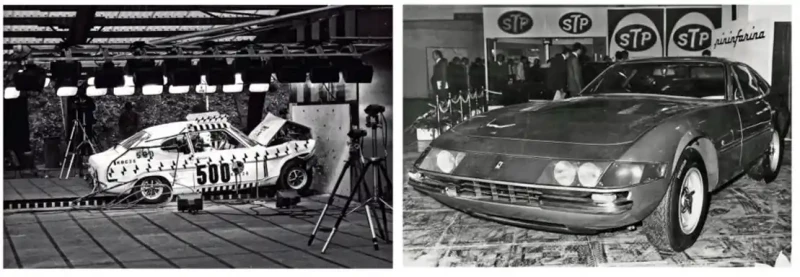
Thanks to: Hexagon (hexagonclassics.com), where this Ferrari is currently for sale at £475,000
Red dream, but Capri still holds its head high.
Spider is launched in Germany, 1971. Just 122 will be made, of which only seven will be right-hand drive, creating a market for coachbuilt conversions.
Earl’s Court, 1970 – the UK sees its first rhd Daytona. But it took a few years, and a home-grown marketing push, before British customers got theirs.
Higher-quality, less ergonomic than Capri Twin bonnet vents aid radiator airflow. 174mph made Daytona 1969’s fastest car. Ultimate GT? Daytona isn’t that practical. Pop-up lights introduced for US regs in 1971.
Quad-cam V12 powered sports prototypes.
Kent powered legions of Formula Fords.
‘Overtaking mirror’: safety with intent.
Plastic pretends to be leather, but change is slick Iconic twin rear lights were a Daytona first Toggle switches give aircraft-cockpit aesthetic.
Ford’s marketing sold the GT dream with glamorous couples and picturesque locales. Most BMC marques aspired to upper-class establishment stuffiness.
Capri’s sense of saloon-car safety and practicality set it aside from coupé rivals from MG and Triumph — and put it in the UK’s top-ten bestseller chart.
Early four-pot cars came minus bonnet bulge Merely having a tacho sign of ’60s sportiness Early Capris shared Escort rear light cluster Dash-integrated radio was slick touch for 1969.
All vinyl and plastic — but looks expensive.

TECHNICAL DATA FILE 1969 Ford Capri 1600GT
- Engine 1599cc in-line four-cylinder, ohv, Weber 32DFE carburettor
- Max Power 86bhp @ 5500rpm
- Max Torque 92lb ft @ 4000rpm
- Transmission Four-speed manual, rear-wheel drive
- Steering Rack and pinion
- Suspension Front: independent, MacPherson struts, track control arms, coil springs, telescopic dampers, anti-roll bar. Rear: live axle, radius arms, semi-elliptic leaf springs, telescopic dampers
- Brakes Discs front, drums rear, servo-assisted
- Performance Top speed: 98mph
- Acceleration 0-60mph: 13.4sec
- Weight 931kg
- Fuel consumption 25mpg
- Cost new £1121
- Classic Cars Price Guide £7500-£21,000
TECHICAL DATA FILE 1973 Ferrari 365 GTB/4 Daytona
- Engine 4390cc V12, dohc per bank, six Weber 40DCN/20 carburettors
- Max Power 352bhp @ 7700rpm
- Max Torque 318lb ft @ 5400rpm
- Transmission Five-speed manual, rear-wheel-drive
- Steering Worm and peg
- Suspension Independent, wishbones, coil springs, telescopic dampers, anti-roll bar front and rear
- Brakes Servo-assisted discs front and rear
- Performance Top speed: 174mph
- Acceleration 0-60mph: 5.4sec
- Weight 1600kg
- Fuel consumption 12mpg
- Cost new £8750
- Classic Cars Price Guide £415,000-£625,000
You’ve got Rolls-Royce ideas on a pushbike income,’ a phrase I haven’t been hit with for a long time. I think the last occasion when it stung my ears was when I dared to entertain notions of one day buying a Seventies Aston V8, at a time when dubious but almost shiny examples seemed plentiful at around £10k. By then I’d graduated from Raleigh Record to Ford Capri 3.0GXL – also dubious and almost shiny – and the Aston seemed only a couple of steps on, allowing for some nifty man maths. Replace those cars with new examples and the journey from one to the other would have seemed an impossible quest at the time, like that between our Capri 1600GT and 365GTB/4 cover stars, cars that shared tarmac in offering the romance of grand touring but were really worlds apart. Viewing each from the perspective of the other was a challenge we gave to Sam Dawson this month, and his story throws fresh light on two highly charismatic GTs from the fast-moving transition of Sixties into Seventies. I can’t imagine Stephen Hawking maths could have made the numbers work to put the Ferrari in my garage, then or now, even one in dubious and not quite shiny condition. It will remain one of those cars I’m content to enjoy on paper and by occasional sight and sound at events, along with a carefully banked memory of borrowing one for the weekend to visit friends in south Wales via a route wilfully avoiding the tedium of motorways and congested towns. On the sort of twiddly little roads that I instinctively and misguidedly first headed for, it felt cumbersome; opened up on sweeping A-roads it came ever more alive with each 10mph increment on the speedo. The sight of that chiselled snout spearing with improbable pace towards the rearview mirrors of the countless cars I passed must have been hard for their startled drivers to comprehend. More than 50 years ago it must have seemed like a visitation from another world. Enjoy the article.


